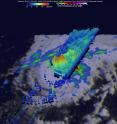NASA's GPM finds extreme rainfall in Typhoon In-fa
The Global Precipitation Measurement mission known as GPM passed over Typhoon In-fa and found extreme rainfall occurring in the storm. GPM is a satellite that can estimate rainfall rates from space. It's a jointly managed satellite by both NASA and the Japan Aerospace Exploration Agency.
On Nov. 21, Typhoon In-fa peaked as a category four tropical cyclone on the Saffir-Simpson scale with maximum sustained winds of about 115 knots (132 mph). In-fa's winds had decreased to about 90 knots (103.5 mph) when the GPM core observatory satellite flew over on November 23, 2015 at 1555 UTC (10:55 a.m. EST). Measurements by GPM's Dual-Frequency Precipitation Radar (DPR) instrument indicated that In-fa was dropping rain at an extreme rate of over 266 mm (10.5 inches) per hour in storms just to the northwest of the typhoon's eye.
GPM's radar (DPR Ku Band) were used to show the powerful convective thunderstorms in 3-D that were producing these extreme rainfall amounts. A few of these tall thunderstorms were found to reach altitudes of over 18 km (11.2 miles).
On Nov. 24 at 1500 UTC (10 a.m. EST) In-fa was centered near 19.7 degrees north latitude and 134.3 degrees east longitude, about 515 nautical miles southwest of Iwo To, Japan. In-fa was moving to the west-northwest at 9 knots (10.3 mph/16.6 kph). Maximum sustained winds had decreased to 75 knots (86.3 mph/138.9 kph), and further weakening is expected.
The Joint Typhoon Warning Center (JTWC) predicts In-fa will weaken even more and be steered rapidly to the northeast as it encounters a mid-latitude trough. In-fa is expected to have maximum sustained winds near 50 knots (57.5 mph/92.6 kph) as it passes near Iwo To on Nov. 26, according to JTWC forecasters.
Source: NASA/Goddard Space Flight Center
Articles on the same topic
- NASA's Terra satellite sees Typhoon In-fa stretchingTue, 24 Nov 2015, 16:04:16 UTC
- NASA eyes Tropical Cyclone Annabelle in Southern Indian OceanTue, 24 Nov 2015, 16:04:01 UTC
- NASA sees In-Fa get better organized, re-strengthenTue, 24 Nov 2015, 16:03:50 UTC
Other sources
- GPM finds extreme rainfall in Typhoon In-fafrom PhysorgTue, 24 Nov 2015, 16:30:34 UTC
- Terra satellite sees Typhoon In-fa stretchingfrom PhysorgMon, 23 Nov 2015, 21:30:27 UTC
- NASA analyzes Tropical Storm In-fa's winds, rainfrom PhysorgThu, 19 Nov 2015, 16:10:18 UTC
- NASA sees In-fa become a Typhoon near Micronesiafrom PhysorgThu, 19 Nov 2015, 10:11:48 UTC
